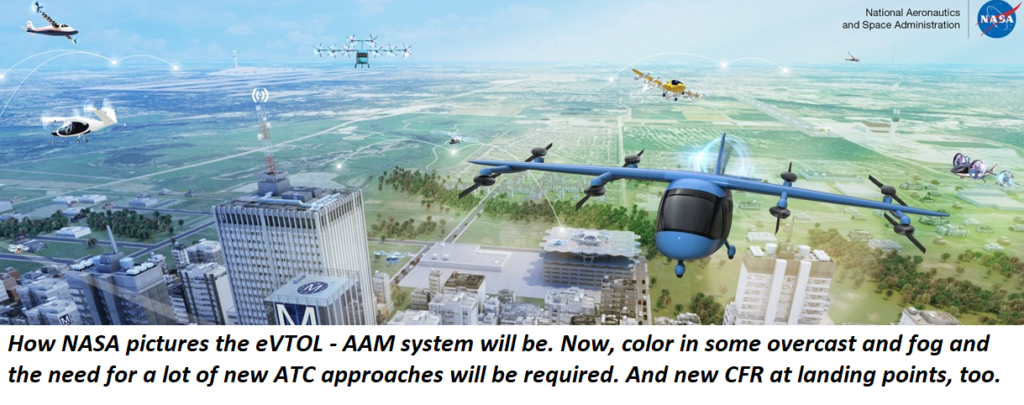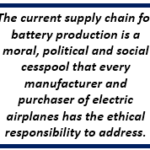Due to the Thanksgiving Holiday, the Monday Insight will be published next week, November 28.
______________________
eVTOL Programs –
Amid The Excitement, Some Key Challenges
American, Delta and United have all announced major investments in establishing future intra-urban airport eVTOL air taxi service within the next five years.
Beyond aircraft with <6 passenger capacity, United has also invested in programs for larger all-electric airliners intended to open near-regional markets.
In all cases, the main benefit and product of these new-concept air transportation programs is time. The driving force in communication progress in the past 40 years has been based on emerging systems that allow flows of information, data, people, and  goods to be done faster. The eVTOL concept appears to be consistent with this goal.
goods to be done faster. The eVTOL concept appears to be consistent with this goal.
For some applications of air service, electronic communication advances have eclipsed its speed value. The internet, web-based information systems, etc. have largely replaced a substantial portion of short-haul O&D air travel. Day trips are in many cases now time- and cost-inferior to electronic communication.
The eVTOL air taxi concept, however, is consistent with this time-trend. On paper, it can provide a channel that can save enormous amounts of time over existing modes of moving people through and across metro areas. And time is the value-proposition.
That much said, there is a lot that needs to be worked out before this concept sees the real-world light of day. Manufacturers of these various machines have a lot more to accomplish beyond just rolling out and flying prototypes.
If the projected and desired date of 2024-2025 for implementation is to be met, these companies need to be at full warp speed.
Let’s take a brief look – one that flashy press releases have not addressed.
Battery Supply. There is no way – none conceivable – that airline CEOs and their boards will tolerate having eVTOL operations  dependent on battery production based on the current supply system. Today, much of the minerals in lithium batteries come from near-slave level mines, particularly cobalt. Whole new supply sources need to be in place before the first eVTOL commercial flight departs Manhattan for Newark. Before. Not after.
dependent on battery production based on the current supply system. Today, much of the minerals in lithium batteries come from near-slave level mines, particularly cobalt. Whole new supply sources need to be in place before the first eVTOL commercial flight departs Manhattan for Newark. Before. Not after.
Battery Production. Today, the majority of battery cell production is in CCP-controlled China. That means these aircraft will be part of a system that supports one of the most ghastly and vile regimes in history. New production facilities need to be constructed for both moral as well as security considerations.
Battery Re-cycling & Disposal. These aircraft will consume a prodigious amount of run-out lithium-ion batteries. An estimate has been made of one set per aircraft per year. Point: what are the administrative and regulatory structures to assure proper  disposal?
disposal?
Emergency & Accident Remediation Systems. As it stands now, when a lithium-ion battery catches fire the only option is to attempt (over sometimes several hours) to drown it in water. Hundreds of thousands of gallons of water. Think about this at an eVTOL site in New York midtown. The strain on the water system is one thing. Then think about this happening in mid-February where the (contaminated) run-off would create a freezing mess choking entire areas of the city. New and safe CFR systems need to be in place.
Actual Operational Costs Are Unknown. With all the unknowns – and knowns – regarding the above, as well as the enormous expense of new eVTOL facilities, the actual per-seat cost to deliver the transportation system now envisioned puts current fare projections in question. If we don’t know what the cost of batteries will be if coming from legitimate and socially acceptable sources, it raises that question.
Air Traffic Control. This is an issue. Today, New York City is already limiting helicopter operations, and there have been suggestions to ban all such flights over city. Look at the depictions put out by even NASA, showing lots of happy eVTOL aircraft flying over a metro area. Then paint into the picture fog and overcast conditions. If the volume of this new transportation mode is to be anything close to what is being envisioned, the ATC system needs to be able to avoid having flying bumper cars over downtown Los Angeles.
Airport Facilities. The introduction of eVTOL systems will require new and additional ramp facilities, passenger handling and electric-support systems. If there are to be dozens of these aircraft in and out of ORD every hour, handing the machines on the ground as well as passenger access and egress will be a new challenge.
Need For Comprehensive Environmental Impact Analyses. Finally, the eVTOL concept is new. It is not primarily replacing fossil-fuel transportation. The number of ground taxis taken out of service will be miniscule, particularly when the comparative costs of eVTOL are factored. It’s not mass transportation.
At the tailpipe, so to speak, these machines will be clean. However, the environmental impact of their total life cycle hasn’t been fully analyzed. The mining of minerals, the transportation of such minerals, the impact of making battery cells, the impact of building support facilities and the disposal of run-out batteries have not been completely vetted.
Summary: This is not to discount the potential economic value of eVTOL-category flying. But these are factors that the manufacturers and operators of these flying machines need to address if it is to be viable.
The excitement about a new transportation system is legitimate. So is the need to validate it.
Now.